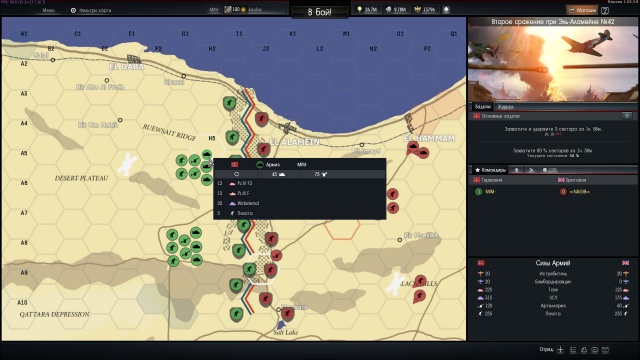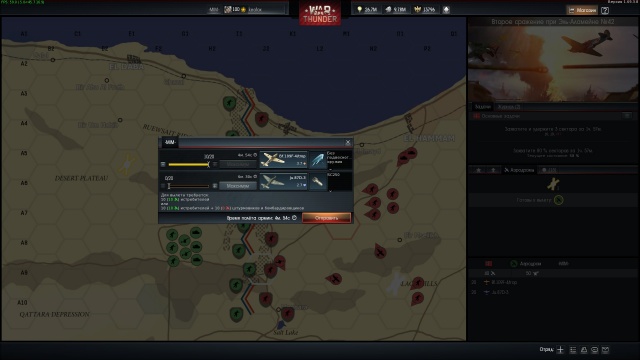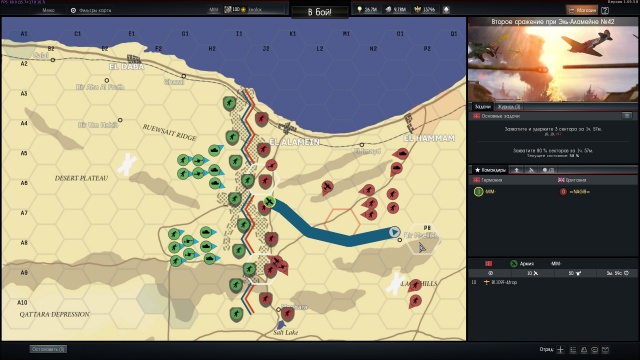Difference between revisions of "World War: For Commanders"
(→Participation) (Tag: Visual edit) |
(Tag: Visual edit) |
||
| Line 37: | Line 37: | ||
==== Sectors ==== | ==== Sectors ==== | ||
The operation map is divided into sectors that define control of the territory and the front line. Each sector can be neutral or belong to one of the sides. | The operation map is divided into sectors that define control of the territory and the front line. Each sector can be neutral or belong to one of the sides. | ||
| + | |||
| + | {{Notice | ||
| + | |Sectors that are not connected to the rear will not be considered to be controlled.}} | ||
Special sectors: | Special sectors: | ||
Revision as of 12:35, 22 May 2019
| This mode differs substantially between squadron commanders and regular soldiers. If you are a squadron member or an unassigned player, we have a handy article for you. |
The game mode with battles occurs on the global map in the form of “Operations”, which are based on historical events.
Battles in World War happen at Realistic Mode difficulty with a special markers mechanic.
Contents
Participation
| Only squadrons with more than 20 members are able to create an operation in World War mode. |
| Squadrons | Squadron Members | Unassigned Players |
|---|---|---|
| Take on the role of one of the warring parties and conduct operations to their end, controlling armies, initiating battles and participating in them.
Squadrons can compete in World War seasons and fight for valuable rewards. |
Can act for their own squadron within an operation and in the role of unassigned players by connecting to any available battles. | Can act as reinforcements, taking open spots in any available battle and helping one side win.
Receive valuable rewards in the High Score List (for all players, whether in squadrons or not) for each game day and at the end of a season. |
Interface
A squadron commander controls armies through a tactical board, which is divided into two sections: the Operation Screen and the Information Panel.
Operation Screen
Military operations run in this part of the screen.
Sectors
The operation map is divided into sectors that define control of the territory and the front line. Each sector can be neutral or belong to one of the sides.
| Sectors that are not connected to the rear will not be considered to be controlled. |
Special sectors:
- Rear Sector – reinforcements may be deployed through a rear sector. In addition, troops receive supplies via the rear sectors.
- Key Sector (bright border) – as a rule, this is a target area to capture or hold in an operation. Also, the more key sectors a side holds, the quicker reinforcements arrive.
Armies
This is the primary combat unit in the Operation. They can participate in battles and capture sectors by advancing the front line. Armies are marked on the operation map with a specific symbol.
| Infantry | Tank | Artillery | Aviation |
|---|---|---|---|
| Motorized infantry (trucks), armoured vehicles and SPAAG | Tank troops and SPAAG | Long-range artillery with SPAAG cover | Fighter Army, Assault Army or Bomber Army |
Airfields
Separate sectors where runways for aviation forces are located.
When you select an airfield, you can see detailed information about available aircraft and armament, as well as form an aviation army.
Information Panel
Additional data regarding objects on the operation map are available here.
Operation Objectives
In each operation, both sides of the conflict have a list of objectives that will lead to a victory if fulfilled. In this menu, you can see the full list of tasks and detailed descriptions of them.
Operation Log
The log stores all events that have occurred since the operation began. The operation log has interactive features. Hovering the cursor over the name of a sector will display it on the map, and clicking on a battle will take you to the screen for this battle if it is still in progress or, if not, show its results.
Battle Menu
| Commanders | Reinforcements | Airfields | Armies |
|---|---|---|---|
| Tab with a list of squadrons taking part in the Operation. | Reinforcements ready for deployment and en route. | List of all your airfields. Selecting an airfield will show you a list of operational aircraft and aircraft being serviced. | A full list of available armies, sorted by current status. |
| The timer next to an army in the Reinforcements tab shows the time until that army arrives. Reinforcements that have arrived can be deployed in the rear sectors. |
Tactics
Operation victories may be awarded for fulfilling various objectives, but to achieve any of them, you will need to move your armies around the Operation map and capture or hold sectors.
Army Management
You can select an army by left-clicking on it and give orders to move or attack by right-clicking.
Ground Army Management
You control all armies with the following keys:
- Right-clicking orders an army to move to a specified point.
- Shift + left-click allows you to create a route with several points or add points to an existing route.
- S gives the order to stop. It can also cancel the current action, such as entrenching or an artillery salvo.
Aside from the tactical aspect of army management, you must also consider the type of terrain over which your armies will travel. The type of terrain affects both the speed of your ground forces and the missions created for ground battles in this map section.
- Road – x1.4
- Village – x1.2
- Off-road – x1.0
- Snow or sand – x0.9
- Forest or fortifications – x0.7
- River – х0.33
- Large bodies of water or mountains – impassable for ground forces
Ground Army Confrontation
- A confrontation between two opposing armies leads to a battle.
- In a confrontation, armies move to the battle point and lose the ability to move until the battle is over.
- Ground forces cannot cut through an ongoing battle. If an army attempts to do this, it will be pushed back and stopped.
Determining whether passage is possible or not is simple – no part of the army piece may contact the battle in progress.
Aviation Army Management
Available aircraft are considered as part of an army only at the time of takeoff. At all other times, they are located at the airfield.
Takeoff
To create an air army, you must select an airfield and specify a point of movement (right click), as with any other army. In the window that opens, select the vehicles to join the army, choose armament presets for each aircraft model, and form an army that meets the game’s minimum requirements.
Armament
Each aircraft departing the airfield receives an armament preset and fuel stores, which are pre-specified by the commander. You may use only this preset in the battle. Armaments and fuel can be refilled only when the army returns to the airfield.
Fuel
Aircraft armies can spend a limited amount of time in the air. Each aircraft’s maximum flight time depends on its maximum possible fuel load. The maximum flight range of an air army is calculated based on the lowest flight range value of all its aircraft. The air army always stows an untouchable fuel provision, which is needed to return to the airfield. If, during the flight, all fuel outside of this reserve runs out, the army stops responding to commands and automatically returns to the base. In the event of a confrontation with enemy forces, the fuel load for the mission is calculated based on the aircraft’s remaining flight time.
Air Army Confrontation
Only an air army can intercept another air army. However, when an air army stops, it will attack any opposing ground army located below it.
| An air army will remember a target if you specify the enemy’s army as the end point of its flight path. It will not pursue targets, but if it stops above several enemy armies, it will attack specifically the targeted army. |
Deploying Reinforcements
The Reinforcements menu in the Information Panel contains a list of the armies in the process of arriving to the operation map. When the timer runs out, these armies can be deployed in the rear sectors and participate in the battle.
Click on the army, then on any rear sector you control for the ground army or on an airfield for your air army. The ground army will deploy immediately. Aircraft will first go to the selected airfield to refuel and load ammunition, after which it will become available.
Army Panel
The army panel contains all information about an army.
- An icon displays the army’s status. Possible statuses: Waiting, Moving, In Combat, Entrenched, or Entrenching.
- Main vehicle type and quantity. If the army does not have enough vehicles, it is considered eliminated and disappears from the operation map.
- Morale (depends on confrontation outcomes. The army that has lost the remainder of its morale by the end of the fight surrenders to the enemy).
- Vehicle List A complete list of an army’s vehicles, where you can see the quantity and their ammunition (for air armies).
Capturing Sectors
To capture sectors, several conditions must be met:
- The sector must not contain the ground armies of the side that previously controlled it.
- The sector must contain at least one ground army from the capturing side OR the sector must be cut off from support (the capturing side must surround the sector on all sides).
When these conditions are met, the other side gains control of the sector.
Battle
A confrontation between two armies begins a battle that members of opposing squadrons and unassigned players may join.
Battles in World War are PvP or PvPvE missions, in which players must complete tasks using the vehicles of opposing armies to achieve victory.
| Battle has not begun (cannot join) | Battle is preparing to start (squadron fighters and, when the timer runs out, unassigned players may join). | Battle has begun (anyone may join, including unassigned players). | Automatic or full battle (cannot join). |
Start of Battle
All generated battles form an operation battle queue and become active as previous battles end. Only four battles may be active at one time during an operation, regardless of occupancy.
If an army does not have enough vehicles to distribute among 20 players when a battle activates, that battle begins in automatic mode.
Connection Timer
An active battle becomes available at the very beginning for squadron players who are participating in the operation to join. Unassigned players for this battle can see a timer. When it runs out, anyone may join the battle.
If there are open spots in a battle in progress, then players can join at any point before it ends.
Vehicles in Battle
Only vehicles in possession of participating armies can be used in a battle. However, they may not be available to the players. Depending on the mission, the AI may control some of an army’s vehicles. Any vehicle losses are recorded as army losses, regardless who controlled them (players or the AI). If all of an army’s available vehicles are lost during battle, players in this army can no longer respawn.
| Incidentally, during battle, you may view a list of the remaining forces for each side in the vehicle selection window. It is displayed in the upper right corner of the interface. |
Battle Type
Battle tasks depend on the confrontation conditions.
- Defence – an attack on an entrenched army with the goal of capturing the defended point.
- Convoy – an attack on a moving formation of armoured vehicles and/or motorized infantry.
- Cover – an attack on bombers or attack aircraft under cover.
- Head-On Course – a direct confrontation between two armies with the goal of mutual elimination.
- Auto Battle – a battle without player participation.
Reinforcements
You may send air army reinforcements into land battle already in progress if your aircraft have yet to engage during this battle. Aircraft will become available to the fighters after the next respawn.
| In this case, you cannot add ground reinforcements. However, you can “trap” your enemy’s army as it exits with your own stronger forces. |
Artillery Attack
An area-effect attack is available to the artillery army directly on the operation map. All armies, including allied armies, located inside the strike radius lose vehicles. An army’s loss depends on how accurately the strike landed the range of fire at the time of each volley. Entrenched armies will sustain significantly fewer losses.
An artillery strike occurs in several stages. First is the guidance stage, followed by a series of volleys. Firing artillery consumes the existing stock of shells. The maximum reserve is enough for a series of 3 volleys. Spent shells are replenished at regular intervals, one volley at a time.
| The artillery army sustains heavy losses in direct confrontations! In an air raid, the battle begins in Anti-Air Defenсe Mode, where fighters can access SPAAG. An attack on a ground army begins an automatic battle. |
Army Destruction
An army with too few vehicles is considered eliminated and disappears from the Operation map.
Also, an army that suffers defeat too often and does not achieve victories loses morale. If its morale reaches 0, that army surrenders and disappears from the Operation map.
Mechanics Features
Entrenchment
Tank and infantry armies have the ability to entrench themselves. An entrenched army suffers significantly less damage from artillery strikes. An attack on an entrenched army begins a Defenсe Battle, which is advantageous for the defenders. Entrenchment takes time.
Retreat
A defeated army that has not been destroyed according to the battle results retreats in the opposite direction, away from the opponent, losing its previously held position and its “Entrenched” status, if it had it. Retreating air armies stop responding to orders and return to the airfield.
Morale
Indicates an army’s morale level. Morale rises with each victory and falls with each defeat. An army with zero morale based on the battle results surrenders to the enemy and disappears from the operation map.
Encirclement
Ground forces located in a sector without a link to the rear are considered encircled. These armies begin losing supplies and will be destroyed after a certain period, which you can track in the army’s information.
Additional Information
| This information will become separate, detailed articles in the future. |
Respawn in World War Battles
World War uses a respawn mode that reflects the confrontation between the armies. Armies have a limited preset of vehicles available to participate in battle, and they are randomly distributed among the players. Several vehicles are available to the player for respawn at any given time. Vehicles are selected at random from the list. The probability of obtaining a particular model depends on the quantity of that vehicle.
Available vehicles are distributed among the squadron’s players. If the player chooses to respawn available vehicles, other members of the squad or squadron will be able to join the battle in the remaining vehicles.
After taking a vehicle into battle, you must wait at least 60 seconds before taking the next vehicle.
Safe Exit Zones in World War Battles
Since each mission follows a confrontation between aircraft already in flight, another defining feature of World War missions is the absence of airfields. Instead, the maps have safe exit zones. If a player abandons an aircraft in a safe exit zone, the aircraft is recorded as a survivor and will not be deducted from the army. However, it will no longer be available for use in that battle.
Good command skills will come with time. In War Thunder’s World War!
Missions in World War
The mission for each battle is selected based on the type and status of the battling armies:
- Fighters vs Fighters – Air Supremacy. The standard mode for pilots. The winner is the one who achieves absolute domination in the skies.
- Fighter vs Attack Aircraft/Bomber – Cover. Attackers must destroy the bomber wing within the allotted time. Cover fighters should prevent them from doing so.
- Attack Aircraft/Bomber vs Attack Aircraft/Bomber – Head-on Course. Each team must escort the bomber wing to a given position. The winner is the one who successfully defends allied bombers.
- Attack Aircraft/Bomber vs Infantry/Tanks (not entrenched) – Convoy. The task for aircraft is to destroy the enemy’s convoy, which will try to prevent this by using SPAAG.
- Attack Aircraft/Bomber vs Infantry/Tanks (entrenched) – Anti-Air Defenсe. The task for aircraft is to destroy the enemy’s defensive positions. The enemy will try to prevent this by using SPAAG.
- Tanks vs Tanks (not entrenched) – Domination. The standard mode for tank operators. The winner is the one who captures and holds 3 points.
- Tanks vs Infantry – Convoy. The task for the attackers is to destroy the enemy’s convoy, which will try to prevent this by using SPAAG.
- Tanks vs Tanks/Infantry (entrenched) or Infantry vs Infantry (entrenched) – Defenсe. The task for the attackers is to destroy the enemy’s defensive positions. The enemy will try to prevent this by using tanks.
The type of terrain does not affect where the mission will take place.







